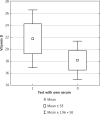Participation of the coagulation system and fibrinolysis as well as selected biomarkers in pathogenesis of chronic urticaria with various activity degree
- PMID: 32994787
- PMCID: PMC7507151
- DOI: 10.5114/ada.2020.98270
Participation of the coagulation system and fibrinolysis as well as selected biomarkers in pathogenesis of chronic urticaria with various activity degree
Abstract
Introduction: Chronic urticaria is a complex disease process in which chronic spontaneous urticaria (CSU) and chronic inducible urticaria are distinguished. Its etiopathogenesis still remains unknown. Some recent studies indicated a significant participation of vitamin D in the etiopathogenesis of urticaria. In 40-50% of patients with CSU on the basis of the positive result of the autologous serum skin test (ASST), autoimmunological background of the disease is diagnosed. Moreover, numerous test results confirm involvement of the coagulation system/fibrinolysis and non-infectious inflammatory factors in the pathophysiology of CSU.
Aim: To determine whether some factors may play a role in pathogenesis and contribute to the severity of chronic spontaneous urticaria.
Material and methods: One hundred and forty-two patients with diagnosed CSU were enrolled in the study. The activity of urticaria was assessed using the UAS-7 (Urticaria Activity Score). The study participants were divided into 4 groups depending on the UAS-7. ASST was performed and blood was collected to determine the biomarkers (CRP, vitamin D, D-dimers, fibrinogen, MPV, PLT).
Results: Statistical analysis was performed using Statistica 13. A statistically significant difference between groups with various activity of urticaria in D-dimer concentration average values (p < 0.05) was observed. Moreover, a statistically significant negative correlation between activity of urticaria and vitamin D concentration (p < 0.001) was noted.
Conclusions: Our results might support the possible involvement of both coagulation and fibrinolysis pathway and vitamin D in the urticaria pathomechanism. Further prospective studies in larger populations conducted at multiple centres are required to expand further our findings.
Keywords: chronic urticaria; coagulation; fibrinolysis; vitamin D.
Copyright: © 2020 Termedia Sp. z o. o.
Conflict of interest statement
The authors declare no conflict of interest.
Figures






Similar articles
-
Causal Relationship between D-Dimers and Disease Status in Chronic Spontaneous Urticaria and Adjuvant Effect of Oral Tranexamic Acid.Indian Dermatol Online J. 2021 Aug 2;12(5):726-730. doi: 10.4103/idoj.IDOJ_106_21. eCollection 2021 Sep-Oct. Indian Dermatol Online J. 2021. PMID: 34667760 Free PMC article.
-
The Role of Coagulation/Fibrinolysis Biomarkers in Pathophysiology, Disease Severity, and Treatment Response in Patients with Urticaria: A Scoping Review.Clin Rev Allergy Immunol. 2025 Mar 10;68(1):25. doi: 10.1007/s12016-025-09036-3. Clin Rev Allergy Immunol. 2025. PMID: 40064711 Free PMC article.
-
Interplay between acute phase response and coagulation/fibrinolysis in chronic spontaneous urticaria.Allergy Asthma Clin Immunol. 2018 Jul 18;14:27. doi: 10.1186/s13223-018-0255-8. eCollection 2018. Allergy Asthma Clin Immunol. 2018. PMID: 30026764 Free PMC article.
-
C-reactive protein is linked to disease activity, impact, and response to treatment in patients with chronic spontaneous urticaria.Allergy. 2018 Apr;73(4):940-948. doi: 10.1111/all.13352. Epub 2017 Dec 7. Allergy. 2018. PMID: 29130488
-
Factors linked to disease severity and time to remission in patients with chronic spontaneous urticaria.J Eur Acad Dermatol Venereol. 2017 Jun;31(6):964-971. doi: 10.1111/jdv.14221. Epub 2017 Apr 4. J Eur Acad Dermatol Venereol. 2017. PMID: 28299827 Review.
Cited by
-
Causal Relationship between D-Dimers and Disease Status in Chronic Spontaneous Urticaria and Adjuvant Effect of Oral Tranexamic Acid.Indian Dermatol Online J. 2021 Aug 2;12(5):726-730. doi: 10.4103/idoj.IDOJ_106_21. eCollection 2021 Sep-Oct. Indian Dermatol Online J. 2021. PMID: 34667760 Free PMC article.
-
The Role of Coagulation/Fibrinolysis Biomarkers in Pathophysiology, Disease Severity, and Treatment Response in Patients with Urticaria: A Scoping Review.Clin Rev Allergy Immunol. 2025 Mar 10;68(1):25. doi: 10.1007/s12016-025-09036-3. Clin Rev Allergy Immunol. 2025. PMID: 40064711 Free PMC article.
-
Dermatologists' knowledge, attitudes, and practices regarding omalizumab therapy for chronic urticaria.Arch Dermatol Res. 2025 Jan 28;317(1):309. doi: 10.1007/s00403-024-03749-9. Arch Dermatol Res. 2025. PMID: 39873817 Free PMC article.
References
-
- Zuberbier T, Aberer W, Asero R, et al. The EAACI/Ga(2) LEN/EDF/WAO Guideline for the definition, classification, diagnosis, and management of urticaria: the 2013 revision and update. Allergy. 2014;69:868–87. - PubMed
-
- Magerl M, Altrichter S, Brzozowa E, et al. The definition, diagnostic testing and management of chronic inducible urticarias. The EAACI/GA2LEN/EDF/UNEV consensus recommendations 2016 update and revision. Allergy. 2016;71:780–802. - PubMed
-
- Zuberbier T, Balke M, Worm M, et al. Epidemiology of urticaria: a representative cross-sectional population survery. Clin Exp Dermatol. 2010;35:869–73. - PubMed
-
- Konstantinou GN, Asero R, Ferrer M, et al. EAACI taskforce position paper: evidence for autoimmune urticaria and proposal for defining diagnostic criteria. Allergy. 2013;68:27–36. - PubMed
LinkOut - more resources
Full Text Sources
Research Materials
Miscellaneous
